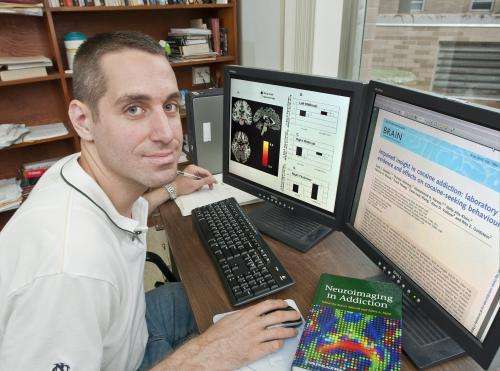Scott J. Moeller.
(Medical Xpress)—Scientists at the U.S. Department of Energy's (DOE) Brookhaven National Laboratory, Stony Brook University, and collaborators may have found a way to predict drug-addicted individuals' responses to drug-related stimuli.
Their research, which was published online in the journal Brain November 12, 2012, may help improve rehabilitation outcomes for individuals with limited awareness of their own choices. This condition, known as impaired insight, makes drug rehabilitation especially difficult.
Using electroencephalography (EEG), a non-invasive way to measure activity in the brain, scientists tracked neurological activity in dozens of individuals as they viewed a series of images on a screen. The scientists were looking for a particular electrical spike known as the late positive potential (LPP), which occurs in response to attention-grabbing stimuli.
"Very pleasant images evoke the LPP, and very unpleasant images do too," explained lead author Scott J. Moeller, a postdoctoral fellow at Brookhaven. "Likewise, cocaine-related images specifically capture the attention of people who are addicted to cocaine."
After each image was shown and viewed passively, participants were asked to rate how emotionally arousing they had found it. Then, once the task was over, they completed a choice task to assess which type of pictures—pleasant, unpleasant, neutral, or drug-related—they preferred to view the most. A final task enabled the researchers to categorize participants into those with impaired insight and those with intact insight.
Arousal ratings from the participants with intact insight were good predictors of which images those participants preferred. However, for those with impaired insight, LPPs proved to be much better predictors than the individual's own ratings.
The research team hopes their results will prove valuable for people in drug rehabilitation in the future.
"You can have all good intentions to abstain from drug use," Moeller said, "but if at the end of the day you can't monitor your behavior, then other kinds of therapy are going to be needed to bring your behavior in line with your intentions. That's what we're thinking of in terms of a long-range clinical translation down the road."
Next, the team plans to use functional magnetic resonance imaging (fMRI), a brain mapping technique that measures changes in blood oxygenation as a proxy for neural activity, to pinpoint which brain regions are compromised in individuals with impaired insight. They are also developing new tests to ascertain the severity of a given person's insight impairment.
Journal information: Brain
Provided by Brookhaven National Laboratory























